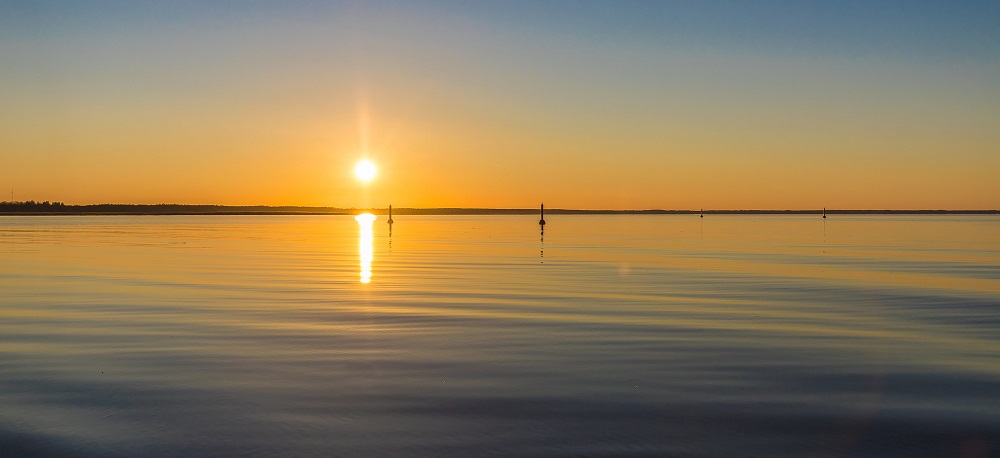The biota of Lake Võrtsjärv is quite rich in species – 35 species of fish have been found here
Lake Võrtsjärv is the second largest lake in Estonia. It has an area of about 270 km2, a length of about 35 km and a width of 15 km in the north, an average depth of 2.8 m, and a maximum depth of 6.0 m. The catchment basin of Lake Võrtsjärv covers 3,380 km2 [1]. Lake Võrtsjärv is a flow-through lake, the water of which changes completely in about one year. Dozens of larger or smaller watercourses flow into the lake, while the Emajõgi River flows out.

The biota of Lake Võrtsjärv is quite rich in species. A total of 114 species of macrophytes (large plants) have been found in Lake Võrtsjärv and its shores. Despite the general species richness, there are few plant rarities in Lake Võrtsjärv. The most common species are the Eurasian watermilfoil, common reed, claspingleaf pondweed, yellow water-lily, and lakeshore bulrush. In addition, hornwort covers large bottom areas as a carpet in the southern part of the lake. The increase in nutrients has been accompanied by a significant increase in reed beds. The number of plant species declines in the direction of south to north. [2]
More than 500 species, varieties, and forms of phytoplankton have been found in Lake Võrtsjärv, but many of them in few numbers. Blue-green algae and diatoms rule the lake, accounting for more than 90% of phytoplankton. More than 250 taxa of zooplankton are found in Lake Võrtsjärv, most of which are rotifers and water fleas [2].
In benthic fauna (invertebrates that live at least part of their life cycle in the bottom sediments of water bodies), nonbiting midges (about 150 different forms) and Oligochaeta (54 species) are the most numerous. Among molluscs, 34 species of snails (mud bithynia, wandering snail) and 36 species of mussels (swollen river mussel, duck mussel, zebra mussel) have been found in Lake Võrtsjärv [2].
35 species of fish have been found in Lake Võrtsjärv, in addition to one Cyclostomata species – the brook lamprey. Lake Võrtsjärv is an important fishing lake. The main commercial fish are zander, eel, bream, and pike, the abundance of which in Lake Võrtsjärv directly influences the success of fishery in Lake Võrtsjärv. There are also a lot of perch and roach. Of the protected species, Lake Võrtsjärv is inhabited by the asp, spined loach, weatherfish, wels catfish, and European bullhead [2].
Lake Võrtsjärv is also important for birds. More than 200 species of birds have been sighted on the lake, of which about 140 species are hatching birds, such as the great crested grebe, great bittern, mallard, garganey, cormorant. Six species of amphibians have been found in Lake Võrtsjärv and its shore area, the most common of which are common frogs and moor frogs. Of the mammals, the water shrew, water vole, muskrat, beaver, and otter live in Lake Võrtsjärv [2].
The water quality of the lake fluctuates
The water quality of Lake Võrtsjärv and, based on this, the condition of the biota depends mostly on the water level. The average annual water level fluctuation is 1.4 m and this causes the water volume to change up to three times. During the years of exceptionally low water levels, the condition of Lake Võrtsjärv deteriorates as the concentration of nutrients increases, which, in turn, causes the rapid growth of the plankton and poor water transparency. As the water level normalises, the condition of the lake usually improves again. Lake Võrtsjärv is a highly nutrient-rich (eutrophic) lake. Polluting fertilisers (nitrogen and phosphorus) come from agriculture and urban wastewater. A clear sign of eutrophication is the rapid expansion of reed beds and the decline of species richness [3].
In recent decades, the pollution load from agriculture has decreased and the Viljandi water treatment plant has been opened. Therefore, the condition of the lake has improved. However, large fluctuations in water levels make it difficult to distinguish between natural and anthropogenic changes [4]. The ecological status of Lake Võrtsjärv was good in 2022 (as in the last couple of years), but due to the bad chemical status, the overall status of Lake Võrtsjärv in 2022 was also poor. [5]
Last modified: 17.11.2023
__________________________________
[1] EELIS: https://register.keskkonnaportaal.ee/register/body-of-water/8378308
[2] Võrtsjärv. (2003). Koostajad: Anto Raukas, Ervin Pihu, Juta Haberman. Tallinn. Eesti Entsüklopeediakirjastus
[3] Nõukogu direktiivi 91/676/EMÜ, veekogude kaitsmise kohta põllumajandusest lähtuva nitraadireostuse eest, täitmine Eestis 2004-2007. (2008). Tallinn. Keskkonnaministeerium: https://www.digar.ee/arhiiv/et/raamatud/21808
[4] Keskkonnaülevaade 2009. Eesti keskkond. Toimetaja: Karmen Kaukver. Keskkonnaministeeriumi Info- ja Tehnokeskus, 2009. Tallinn: https://www.digar.ee/arhiiv/et/raamatud/57586
[5] L. Eek. TOP 6 tähelepanekut 2022. aasta pinnavee seisundi tulemustest. Keskkonnaagentuur, 2023